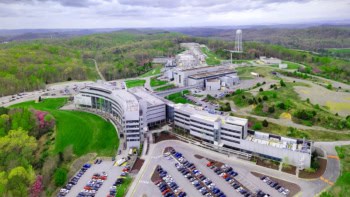
By Michael Banks
Following the closure of Fermilab’s 1 TeV Tevatron particle collider near Chicago in 2011 – and with no similar facility being planned to replace it in the US – many physicists in the country felt not surprisingly concerned that America was losing its place at the “energy frontier”. That baton had already passed to the CERN particle-physics lab near Geneva when its Large Hadron Collider (LHC) fired up in 2008, and with collisions set to restart there next year at 13 TeV, the US’s day looked certain to have passed.
Indeed, as we first reported three weeks ago, researchers meeting in Geneva last week discussed plans that would keep Europe at the energy frontier for decades to come with options for an LHC successor – a machine that would be even bigger and bolder that the 27 km-circumference LHC.
One new design tabled at the conference would involve creating a huge 80–100 km tunnel near Geneva that would house a new collider to study the Higgs boson in great detail. In the future, this tunnel could then be used to search for new particles by colliding protons at 100 TeV – much greater than the LHC’s 13 TeV.
However, a group of US physicists from Texas A&M University and Michigan State University is now proposing to wrestle back the energy frontier by constructing a huge accelerator in the US.
In a paper posted on the arXiv preprint server today, the researchers outline plans to use the partly constructed tunnel of the axed Superconducting Super Collider (SSC) just outside Dallas, Texas. Conceived in 1983, the SSC was to be the next big particle collider with a circumference of 87 km and a maximum collision energy of 40 TeV. But 10 years later the all-American project was cancelled, largely on grounds of cost, leaving a few buildings on the surface as well as tens of kilometres of tunnels deep underground.
Most of the cost of a new collider would be in excavating the tunnel, but the researchers claim that around 46% of the SSC tunnel has been already bored and some facilities built, such as the linear accelerator that feeds particles into the collider. This would then make it much cheaper than the CERN proposal.
The physicists point out that if the SSC tunnel were finished off, it could be home to a 240 GeV “Higgs factory” that would collide electrons with positrons to study the new boson in unprecedented detail.
But their plans don’t stop there. The researchers say that given its “soft consolidated cretaceous rock”, the site in Texas is an “ideal medium for large-bore tunnelling”. This same location could be home to a 270 km-circumference particle collider that could then host a 100 TeV proton–proton machine. The SSC tunnel would be used as an injector into the new 270 km tunnel. The authors add that in future the collider could even be upgraded to a 300 TeV machine.
There’s nothing like thinking big!
But if the plans do go ahead, there may be some clearing up to do first. During the 2011 March Meeting of the American Physical Society in Dallas, a group of “rogue” physicists (see image above) took a break from the gruelling conference schedule to break into the SSC’s derelict site. They found that the tunnels are well below the water table and are therefore flooded, while many unopened crates containing electronic equipment are just lying around.
Yet the authors seem serious about their plans and have submitted the document to a subpanel of Department of Energy’s High Energy Physics Advisory Panel, and are planning to discuss the proposal at a workshop at Fermilab in July.


